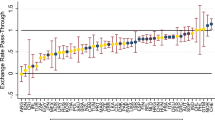Abstract
The real exchange rate is defined as the relative price of nontradables and tradables. An index of the relative price is constructed for the U.S. and used to explain net exports. The index appears to perform better in explaining net exports than a comparable purchasing power parity real exchange rate. The relative price of nontradables, in turn, is shown to be cointegrated with a set of variables that drive the demand for and supply of nontradables. These variables capture long-run structural and demographic changes of the U.S. economy, such as the increased demand for medical services.
Similar content being viewed by others
References
Arndt, S.W. (1990) “Industrial Structure, Competitiveness, and Trade”North American Review of Economics and Finance 1, 217–224.
Balassa B. (1964) “The Purchasing Power Parity Doctrine: A Reappraisal”Journal of Political Economy 72, 584–596.
Bautista, R.M. (1987)Production Incentives in Philippine Agriculture: Effects of Trade and Exchange Rate Policies, Research Report No. 59. Washington, D.C.: International Food Policy Research Institute.
Cottani J.A., D.F. Cavallo, and M.S. Khan (1990) “Real Exchange Rate Behavior and Economic Performance in LDCs”Economic Development and Cultural Change 39, 61–76.
Coughlin, C.C. and K. Koedijk (1990) “What Do We Know About the Long-Run Real Exchange Rate?” Federal Reserve Bank of St. LouisReview 72, 36–48.
Cox, W.M. (1987) “A Comprehensive New Real Dollar Exchange Rate Index”, Federal Reserve Bank of DallasEconomic Revie, 1–14.
U.S. Department of Health, Education, and Welfare (1992)Digest of Education Statistics 1992. Washington, D.C.: Office of Education.
Dornbusch, R. (1976) “Expectations and Exchange Rate Dynamics”Journal of Political Economy 84, 1161–1176.
Dornbusch, R. (1980)Open Economy Macroeconomics. New York: Basic Books.
Dorosh, P. and A. Valdés (1990)Effects of Exchange Rate and Trade Policies on Agriculture in Pakistan. Research Report No. 84. Washington, D.C.: International Food Policy Research Institute.
Edison, H.J. and J.T. Klovland (1987) “A Quantitative Reassessment of the Purchasing Power Parity Hypothesis: Evidence from Norway and the United Kingdom,”Journal of Applied Econometrics 2, 309–333.
Edwards, S. (1989)Real Exchange Rates, Devaluation, and Adjustment. Cambridge, Mass.: MIT Press.
Engle, R.F. and C.W.J. Granger (1987) “Co-Integration and Error Correction: Representation, Estimation and Testing”,Econometrica 55, 251–276.
Fair, R.C. and K.M. Dominguez (1991) “Effects of the Changing U.S. Age Distribution on Macroeconomic Equations,”American Economic Review 81, 1276–1294.
Frankel, J.A. (1979) “On the Mark: A Theory of Floating Exchange Rates Based on Real Interest Differentials,”American Economic Review 69, 610–622.
Frenkel, J.A. and M.M. Mussa (1985) “Asset Markets, Exchange Rates and the Balance of Payments.” In R.W. Jones and P.B. Kenen (eds.),Handbook of International Economics Vol. 2, Amsterdam: North-Holland, pp. 679–747.
Garcia, J.G. (1981)The Effects of Exchange Rates and Commercial Policy on Agricultural Incentives in Colombia: 1953–1978, Research Report No. 24. Washington, D.C.: International Food Policy Research Institute.
Hakkio, C.S. and M. Rush (1991) “Cointegration: How Short is the Long Run?”Journal of International Money and Finance 10, 571–581.
Helkie, W.L. and E.E. Meade (1987) “USIT's Current Account Forecasting Model,” Unpublished report, Board of Governors of the Federal Reserve System, November 4.
Hsieh, D.A. (1982) “The Determination of the Real Exchange Rate,”Journal of International Economics 14, 355–362.
Isard, P. (1983) “An Accounting Framework and Some lssues for Modelling How Exchange Rates Respond to the News.” In J.A. Frenkel (ed.),Exchange Rates and International Macroeconomics. Chicago: University of Chicago Press, pp. 19–56.
MacKinnon, J. (1991) “Critical Values for Cointegration Tests.” In R.F. Engle and C.W.J. Granger (eds.),Long-Run Economic Relationships: Readings in Cointegration. New York: Oxford University Press, pp. 267–276.
Pauls, B.D. (1987) “Measuring the Foreign-Exchange Value of the Dollar,”Federal Reserve Bulletin 73, 411–422.
U.S. Bureau of the Census (various years)Statistical Abstract of the United States, Washington, D.C.
U.S. Federal Bureau of Investigation (various years)Uniform Crime Reports for the United States Washington, D.C.
Wolff, C.C.P. (1987) “Time-Varying Parameters and the Out-of-Sample Forecasting Performance of Structural Exchange Rate Models,”Journal of Business and Economic Statistics 5, 87–97.
Author information
Authors and Affiliations
Rights and permissions
About this article
Cite this article
Zietz, J. The relative price of tradables and nontradables and the U.S. trade balance. Open Econ Rev 7, 147–160 (1996). https://doi.org/10.1007/BF01891901
Issue Date:
DOI: https://doi.org/10.1007/BF01891901




